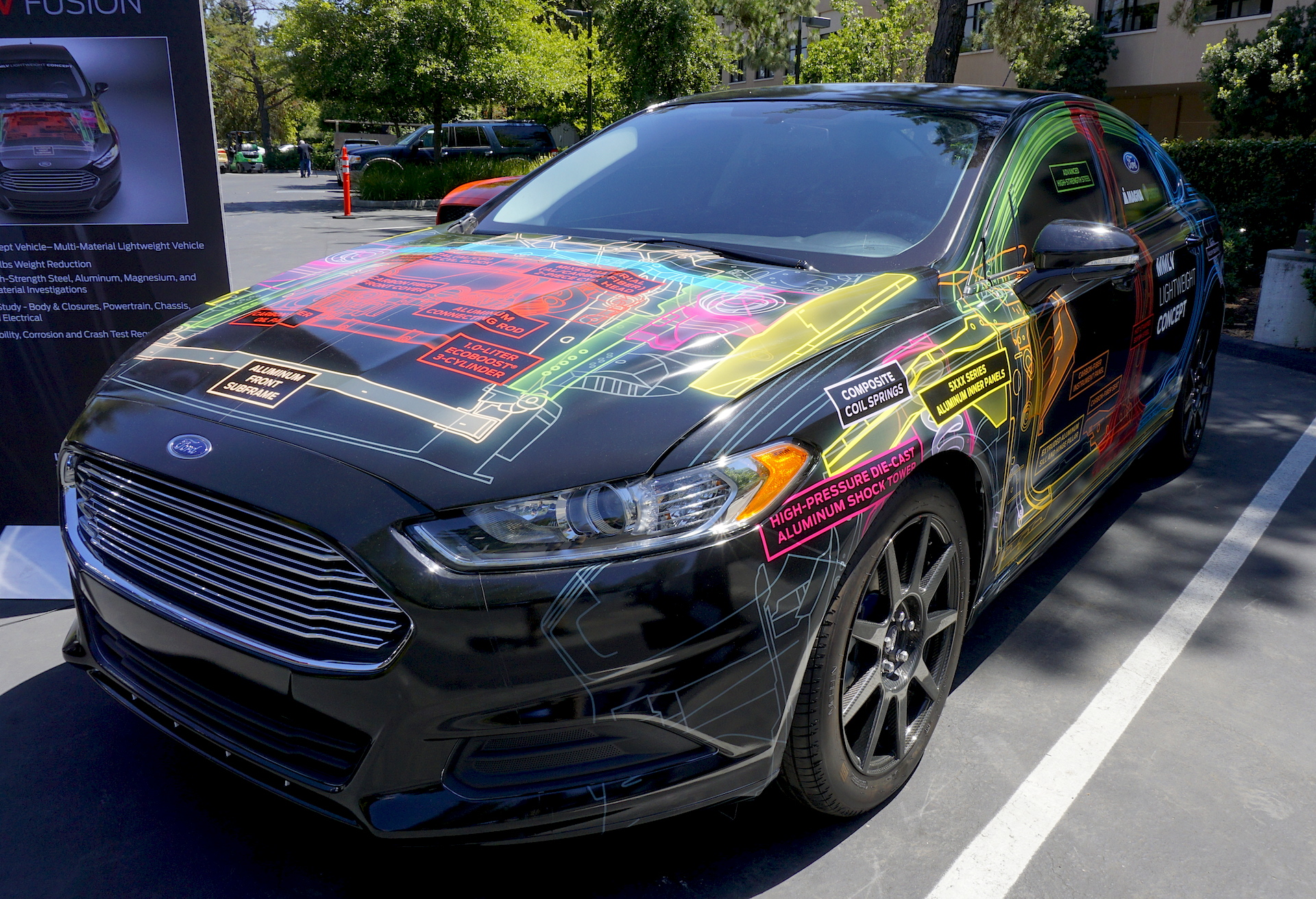Ford's New GT Supercar Has (Some) Eco Cred
It's not electric, but with a turbo V6 engine and carbon-fiber body, the 600-horsepower GT supercar is greener than an average muscle car.

It's a far cry from a Prius, but Ford's premium sports car, the 2015 GT, cuts gas consumption with a smaller V6 turbo engine and extensive use of lightweight materials like carbon fiber. Meanwhile, it achieves about the same 600-plus horsepower as its 2005, V8-powered predecessor.
Introduced in January and due to go on sale next year, at $400,000, the GT both borrows engine tech from Ford's mainstream cars and debuts lightweight materials. These, the company expects to trickle down to future economy cars and pickup trucks.
MORE: Connected Cars: A 2015 Guide to New Vehicle Technology
It starts with the 3.5-liter turbocharged V6 engine (which will also be in the next Raptor truck). Ford introduced its EcoBoost-branded turbo technology with an engine of the same size that premiered in 2009 in the Taurus SHO. A luxury sedan going up against competitors like the Audi A8, the Taurus SHO was no economy model, but also no extreme sports car. "We were the first to use a turbo V6 in place of what would have been a V8 in that class of car," Steve Russ, Ford's technical leader for internal combustion engines, told me during a visit to the company's new innovation center in Palo Alto, California.

Ford's EcoBoost turbo engines also developed from far-humbler roots in its European division, with a tiny 1.6-liter engine in the mainstream Focus and Fusion models. Ford now uses seven EcoBoost engines — ranging from 1.0- to 3.5-liter displacement, throughout the company's lineup. "It's been tuned to achieve fuel economy across many of our products, and it's been tuned to achieve performance in the GT," said Russ.

Technologies may also be trickling up from a prototype based on Ford's midpriced car, the Fusion (starting at $22,110). The Fusion prototype uses lightweight materials throughout to shave off about 25 percent of the weight of the production model. The Fusion's prototype carbon-fiber wheels, for example, are already on the new Mustang GT350R muscle car and could be an option on the GT supercar, said Ford spokesman Paul Seredynski.
Carbon-fiber replacements for aluminum parts in the Fusion could also appear in future cars, said Matt Zaluzec, Ford's technical lead for global materials and manufacturing. As a hypothetical example, he mentioned the carbon-fiber-reinforced plastic oil pan developed for the Fusion concept car and how it might move up to other cars. "[If] we fully test out the carbon fiber, it's not a leap of faith to say … we can apply it," said Zaluzec, adding, "We're just not there yet."
Sign up to get the BEST of Tom's Guide direct to your inbox.
Get instant access to breaking news, the hottest reviews, great deals and helpful tips.
Showing even greater influence, green technologies have trickled down from the GT line. The previous model, from 2005, was Ford's first full-production all-aluminum car. A decade later, the company has introduced an aluminum body, which saves weight and therefore fuel, in its 2.7-liter, V6-powered F-150 pickup. This is by far Ford's biggest-production vehicle, with more than 750,000 of the trucks sold in 2014. (Its frame, however, continues to be made of steel for heavy-duty tasks like hauling thousands of pounds.)
MORE: The Best Cars from the 2015 New York Auto Show
Will history repeat itself with a carbon-fiber F-150 someday? Ford spokesman Paul Seredynski seemed to hint at that in our conversation. "You look at the product arc — 2005, we had our first all-aluminum car, the Ford GT supercar," he said. "2015, we have an all-aluminum pickup truck.

"So now, we're looking at a carbon-fiber GT," he continued. "Our next GT is carbon fiber. So you can extrapolate." Seredynski later walked back from that comment, though, telling me he hadn't intended to hint at a carbon-fiber truck.
Despite the labeling and fuel savings, Ford's EcoBoost cars are powered by gasoline, which is still eco-unfriendly. Underscoring that disconnect Ford did show off its new vehicles in California, whose governor has just pledged to cut the state's greenhouse gas emissions by 40 percent.
- Apple CarPlay FAQ: Everything You Need to Know
- Pioneer Adds Android Auto to Its NEX In-Dash Receivers
- Chevy's Self-Driving Concept Car Blurs Sci-Fi and Reality
Follow Senior Editor Sean Captain @seancaptain. Follow us @tomsguide, on Facebook and on Google+.
Sean Captain is a freelance technology and science writer, editor and photographer. At Tom's Guide, he has reviewed cameras, including most of Sony's Alpha A6000-series mirrorless cameras, as well as other photography-related content. He has also written for Fast Company, The New York Times, The Wall Street Journal, and Wired.
-
Rick W I vote YES for progress!!! If you don't like new technology, then you're probably old and will die soon anyways, so nobody really cares about what you think about progress.Reply -
ldogg1981 "Ford's EcoBoost cars are powered by gasoline, which is still eco-unfriendly." And so are batteries, unless they are charged by the sun, and the entire production and shipment of all materials required to make those batteries was powered by the sun. Battery powered cars probably cause more pollution than gas powered cars since the raw materials to make the batteries are mined in africa or china and shipped on a boat ( that uses more gasoline than will ever be saved by using batteries) to another continent where the batteries are assembled and put on another boat and shipped to the U.S. where they are installed in cars that make hippies think they are protecting the environment.Reply -
mjcutri I guess this is why you don't go to a tech site for auto news...Reply
The "Focus" prototype is actually a Fusion. (You can even see "Fusion" in the top left of the photo)
